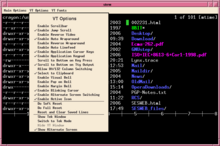Software feature


In software, a feature is an identifiable characteristic of a computer program. [1]
Context
The term feature means the same for software as it does for any kind of system. For example, the British Royal Navy's
Feature also applies to computer hardware. In the early history of computers, devices such as Digital Equipment Corporation's PDP-7 minicomputer (created in 1964) was noted for having a wealth of features, such as being the first version of the PDP minicomputer series to use wire wrap, as well as being the first to use the proprietary DEC Flip-Chip module which was invented in the same year.[3][4]
Feature also applies to concepts such as a programming language. The
Another similar high-level, object oriented programming language, Ruby, is noteworthy for using the symbols "@" and "$" to highlight different variable scopes, which the developers claim improves code readability. Its developers also claim that one of its important features is a high amount of flexibility.[6]
The
Although feature is typically used for a positive aspect of a software system, a software bug is also a feature but with negative value.
Examples
The terminal emulator
Feature-rich and feature creep
Feature-rich describes a software system as having many options and capabilities.
One mechanism for introducing feature-rich software to the user is the concept of progressive disclosure, a technique where features are introduced gradually as they become required, to reduce the potential confusion caused by displaying a wealth of features at once.[10]
Sometimes, feature-rich is considered a negative attribute. The terms feature creep, software bloat, and featuritis refer to software that is overly feature-rich.[11] This type of excessive inclusion of features is in some cases a result of design by committee.[12]
To counteract the tendency of software developers to add additional, unnecessary features, the Unix philosophy was developed in the 1970s by Bell Labs employees working on the Unix operating system such as Ken Thompson and Dennis Ritchie. The philosophy can be summarized as: software programs should generally only complete one primary task and that "small is beautiful".[13][14]
See also
- Feature-oriented programming
- Product family engineering
- Software design
- Software testing
- Application lifecycle management
- Feature creep
- Scope creep
- Overengineering
References
- S2CID 417250.
- ^ "How the Dreadnought sparked the 20th Century's first arms race".
- ^ "PDP-7". reference.com Computing Dictionary. Archived from the original on June 16, 2013.
- ^ Tore Sinding Bekkedal (2009). "Digital Equipment Corporation PDP-7". soemtron.org.
- ^ "PEP 8 – Style Guide for Python Code".
- ^ "About Ruby".
- ^ IEEE Std. 829-1998
- ^ "XTERM - Change Log - Patch #24 - 1996/8/11 - XFree86 3.1.2Ee". Archived from the original on 2001-12-22.
- ^ Thomas E. Dickey. "XTerm – Frequently Asked Questions (FAQ), Who wrote XTerm?". Archived from the original on 2018-06-24. Retrieved 2018-06-04.
- )
- ^ "Featuritis (or creeping featurism)".
- S2CID 250326876.
- Doug McIlroy; E. N. Pinson; B. A. Tague (8 July 1978). "Unix Time-Sharing System: Foreword". The Bell System Technical Journal. Bell Laboratories: 1902–1903.
- ^ "The Unix Philosophy".
